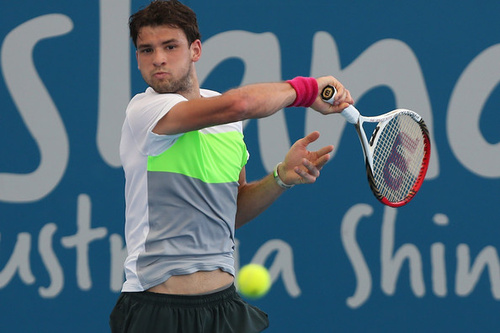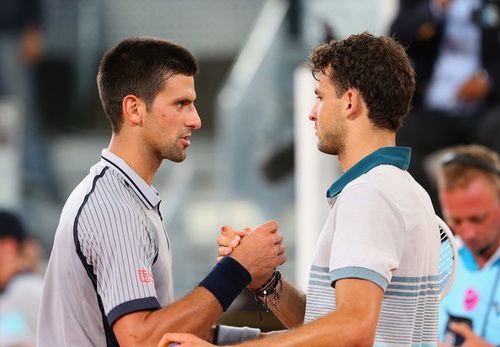Don't miss any stories → Follow Tennis View
FollowATP Breakthrough of the Year: Grigor Dimitrov
He was not unknown to the tennis world before 2013. But Grigor Dimitrov was known less as himself than as an uncanny replica of someone much more familiar. Viewers tuned into his matches to marvel at the resemblance between the games of this Bulgarian and Roger Federer, from their one-handed backhands to their service motions. Once applied to Richard Gasquet, the sobriquet of “Baby Fed” clung to Dimitrov as he searched for the consistency that would allow him to escape the second tier.
When this season began, doubters could point to many reasons why Dimitrov might not become known for anything more than his resemblance to Federer. Never had he reached the final at any ATP tournament, nor had he defeated a member of the ATP Big Four, comprised of Novak Djokovic, Rafael Nadal, Andy Murray, and Federer. In fact, so inconsistent were his results that he rarely had played an opponent of significance at a marquee event in a televised match. To gain respect as a talent in his own right, rather than just another “Baby Fed,” Dimitrov needed to win more of the matches that he was supposed to win and set up clashes with the elite from which he could build experience.

The 21-year-old Bulgarian lost no time in notching an important step forward. At his first tournament of 2013, an Australian Open warm-up in Brisbane, he blazed to his debut final through a field of talented opponents. Among them was Milos Raonic, the Canadian phenom further along his trajectory of development than Dimitrov. In the final against Murray, Dimitrov nearly snatched the first set before faltering in a tiebreak. Their tense encounter presaged his next two encounters with the Big Four at Indian Wells and Miami. Aligned against Djokovic on the first occasion and Murray on the second, Dimitrov served for the first set both times. His nerves deserted him on both occasions, causing ugly double faults and unforced errors. Yet those matches showed how close he could come to challenging the best of the ATP, once he learned how to master the moment.
Probably least formidable on clay of all surfaces, Dimitrov achieved his next breakthrough there. He thrust Nadal deep into the third set of a high-quality battle in Monte Carlo, showing few signs of nerves despite facing the best clay player in history. That battle may have steeled Dimitrov for the massive test that awaited him in Madrid. There, the draw bracketed him near world No. 1 Novak Djokovic, infused with momentum after he had defeated Nadal to win the Monte Carlo title. Few observers gave Dimitrov a real chance to win.
Win he did, however, in an epic three-set battle that turned the eyes of the tennis world onto him. Dimitrov again failed to serve out the first set, but this time he rallied to eke out the tiebreak that followed. As none would have doubted, Djokovic showed his resilience by evening the match after another tiebreak in which he saved match points. Many underdogs would have yielded at that stage, content with forcing the world No. 1 to the brink of defeat. Dimitrov refused to accept his moral victory, redoubling his effort when the third set began and protecting an early lead en route to the upset.

That stirring breakthrough did not turn the Bulgarian overnight into a contender. Like many rising stars, he faded back into obscurity after his first signature triumph. Not until Cincinnati, when he again extended Nadal to a final set, did Dimitrov resurface on the radar of most fans. That match marked the start of a four-match losing streak, however, including a bizarre loss at the US Open that confirmed widespread notions of his fragility.
That skid did not deplete Dimitrov’s confidence when he arrived at an indoor hard-court tournament in Stockholm. Able to exploit a favorable draw, he showed that he could outclass foes of an inferior level by cruising to the semifinals without losing a set. Adversity arrived there when the big-serving, equally mercurial Benoit Paire won the first set. Showing himself the steadier on that day of the two rising stars, Dimitrov swept through the next two sets to reach his second final of 2013. Across the net from him there stood world No. 4 David Ferrer, who has become famous for throttling sub-elite competition and rarely losing matches that he should win.
The Stockholm final surely fell in that category, and Ferrer cruised through a 6-2 first set of uneventful tennis. One game at a time, though, Dimitrov patiently clawed back into the match. After he reversed the momentum, he did not allow the alert, tenacious Ferrer a chance to regroup. Reacting with euphoria to winning his first title, Dimitrov surely reflected on his long road to reach that milestone.
Much work remains for the Bulgarian talent, who ended his 2013 campaign inside the top 25 after starting it barely inside the top 50. For example, Dimitrov still has not reached the second week at a major. He lost five-setters at Wimbledon to Grega Zemlja and at the US Open to Joao Sousa, not opponents who should halt him. Those struggles in the best-of-five format hint at lingering concerns over fitness. Dimitrov also continues to struggle with nerves at pivotal moments. Even after the Stockholm breakthrough, he lacked confidence in failing to serve out a set against Federer in Basel. Finally, his one-handed backhand remains a vulnerable shot that can crumble under pressure.
As Dimitrov seeks to sharpen those weaknesses, he should reflect back on this season with pride. His maiden title, first victory over a world No. 1, and top-30 debut all suggested that his stock is rising more quickly than most men of the ATP’s Generation Next. If he needs any further moral support, Dimitrov can rely on his famous new girlfriend, Maria Sharapova. The presence of the statuesque Russian should offer all of the encouragement that any man could need.











